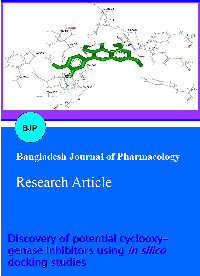Discovery of potential cyclooxygenase inhibitors using in silico docking studies
DOI:
https://doi.org/10.3329/bjp.v7i1.10007Keywords:
Binding energy, Inhibition constant, Intermolecular energy, CyclooxygenaseAbstract
This study deals with the evaluation of the cyclooxygenase inhibitory activity of flavonoids (tangeritin, morin, rhamnetin, theaflavin, pachypodol, eriodictyol, homoeriodictyol, aromadedrin, okanin) using in silico docking studies. In silico docking studies were carried out using AutoDock 4.2. Three important parameters like binding energy, inhibition constant and intermolecular energy were determined. The results showed that all the selected flavonoids showed binding energy ranging between -8.77 kcalmol-1 to -6.10 kcalmol-1 when compared with that of the standard (-8.30 kcalmol-1). Intermolecular energy (-10.56 kcalmol-1 to -7.89 kcalmol-1) and inhibition constant (373.91 nM to 34.03 µM) of the ligands also coincide with the binding energy. All the selected flavonoids contributed cyclooxygenase inhibitory activity because of its structural parameters. These molecular docking analyses could lead to the further development of potent cyclooxygenase inhibitors.
Downloads
428
324 Read
26
References
Cavasotto CN, Abagyan RA. Protein flexibility in ligand docking and virtual screening to protein kinases. J. Mol. Biol. 2004; 12: 209-25.
Chang MW, Ayeni C, Breuer S. Virtual screening for HIV protease inhibitors: A comparison of AutoDock 4 and vina. PLoS ONE. PLoS ONE. 2010; 5: 119-55.
Collignon B, Schulz R, Smith JC. Task-parallel message passing interface implementation of AutoDock4 for docking of very large databases of compounds using high-performance supercomputers. J Comput Chem. 2011; 32: 1202-09.
Cosconati S, Forli S, Perryman AL, Harris R, Goodsell DS, Olson AJ. Virtual Screening with AutoDock: Theory and practice. Exp Opin Drug Disc. 2010; 5: 597-607.
Formica JV, Regelson W. Review of the biology of quercetin and related bioflavonoids. Food Chem Toxicol. 1995; 33: 1061-80.
Goodsell DS, Morris GM, Olson AJ. Automated docking of flexible ligands: Applications of AutoDock. J Mol Recog. 1996; 9: 1-5.
Groot H, Rauen U. Tissue injury by reactive oxygen species and the protective effects of flavonoids. Fundam Clin Pharmacol. 1998; 12: 249-55.
Herschman HR. Prostaglandin synthase 2. Biochim Biophys Acta Lipids Lipid Metab. 1996; 1299: 125-40.
Jiang Q, Ames BN. λ-Tocopherol, but not α-tocopherol, decreases proinflammatory eicosanoids and inflammation damage in rats. FASEB. 2003; 17: 816-22.
Khodade P, Prabhu R, Chandra N. Parallel implementation of Autodock. J App Crystal. 2007; 40: 598-99.
Konc J, Konc JT, Penca M, Janezic M. Binding-sites prediction assisting protein-protein docking. Acta Chim Slov. 2011; 58: 396-401.
Koppen H. Virtual screening: What does it give us? Curr Opin Drug Disc Dev. 2009; 12: 397-407.
Kurumbail RG, Stevens AM, Gierse JK, McDonald JJ, Stegeman RA, Park JY, Gildehaus D, Miyashiro JM, Penning TD, Seibert K, Isakson PC, Stallings WC. Structural basis for selective inhibition of cyclooxygenase 2 by antiinflammatory agents. Nature 1996; 384: 644.
Madeswaran A, Umamaheswari M, Asokkumar K, Sivashanmugam T, Subhadradevi V, Jagannath P. Docking studies: In silico lipoxygenase inhibitory activity of some commercially available flavonoids. Bangladesh J Pharmacol. 2011; 6: 117-23.
Middleton EJ, Effect of plant flavonoids on immune and inflammatory cell function. Adv Exp Med Biol. 1998; 439: 175-82.
Morris GM, Huey R, Lindstrom W, Sanner MF, Belew RK, Goodsell DS, Olson JA. J Comput Chem. 2009; 30: 2785-91.
Park H, Lee J, Lee S. Critical assessment of the automated AutoDock as a new docking tool for virtual screening. Proteins 2006; 65: 549-54.
Schames JR, Henchman RH, Seigel JS, Sotriffer CA, Ni H, McCammon A. Discovery of a Novel Binding Trench in HIV Integrase. J Med Chem. 2004; 47: 1879-81.
Schoichet BK. Virtual screening of chemical libraries. Nature 2004; 43: 862-65.
Seeliger D, Groot BL. Ligand docking and binding site analysis with PyMOL and AutoDock/Vina. J Comput Aided Mol Des. 2010; 24: 417-24.
Smith CJ, Morrow JD, Roberts LJI, Marnett LJ. Differentiation of monocytoid THP-1 cells with phorbol ester induces expression of prostaglandin endoperoxide synthase-1 (COX-1). Biochem Biophys Res Commun. 1993; 192: 787-93.
Smith RM, DeWitt DL, Garavito RM. Cyclooxygenases: Structural, cellular and molecular biology. Ann Rev Biochem. 2000; 69: 145-52.
Umamaheswari M, Madeswaran A, Asokkumar K, Sivashanmugam T, Subhadradevi V, Jagannath P. Discovery of potential xanthine oxidase inhibitors using in silico docking studies. Der Pharma Chemica. 2011; 3: 240-47.
Vane JR, Bakhle YS, Botting RM. Cyclooxygenases 1 and 2. Annu Rev Pharmacol Toxicol. 1998; 38: 97-120.

Published
How to Cite
Issue
Section
License
Authors who publish with this journal agree to the following terms:
- Authors retain copyright and grant the journal right of first publication with the work simultaneously licensed under a Creative Commons Attribution License that allows others to share the work with an acknowledgement of the work's authorship and initial publication in this journal.
- Authors are able to enter into separate, additional contractual arrangements for the non-exclusive distribution of the journal's published version of the work (e.g., post it to an institutional repository or publish it in a book), with an acknowledgement of its initial publication in this journal.
- Authors are permitted and encouraged to post their work online (e.g., in institutional repositories or on their website) prior to and during the submission process, as it can lead to productive exchanges, as well as earlier and greater citation of published work (See The Effect of Open Access).
